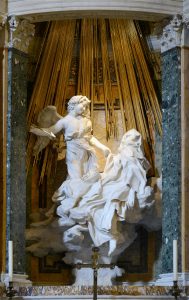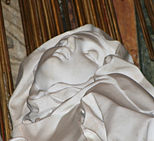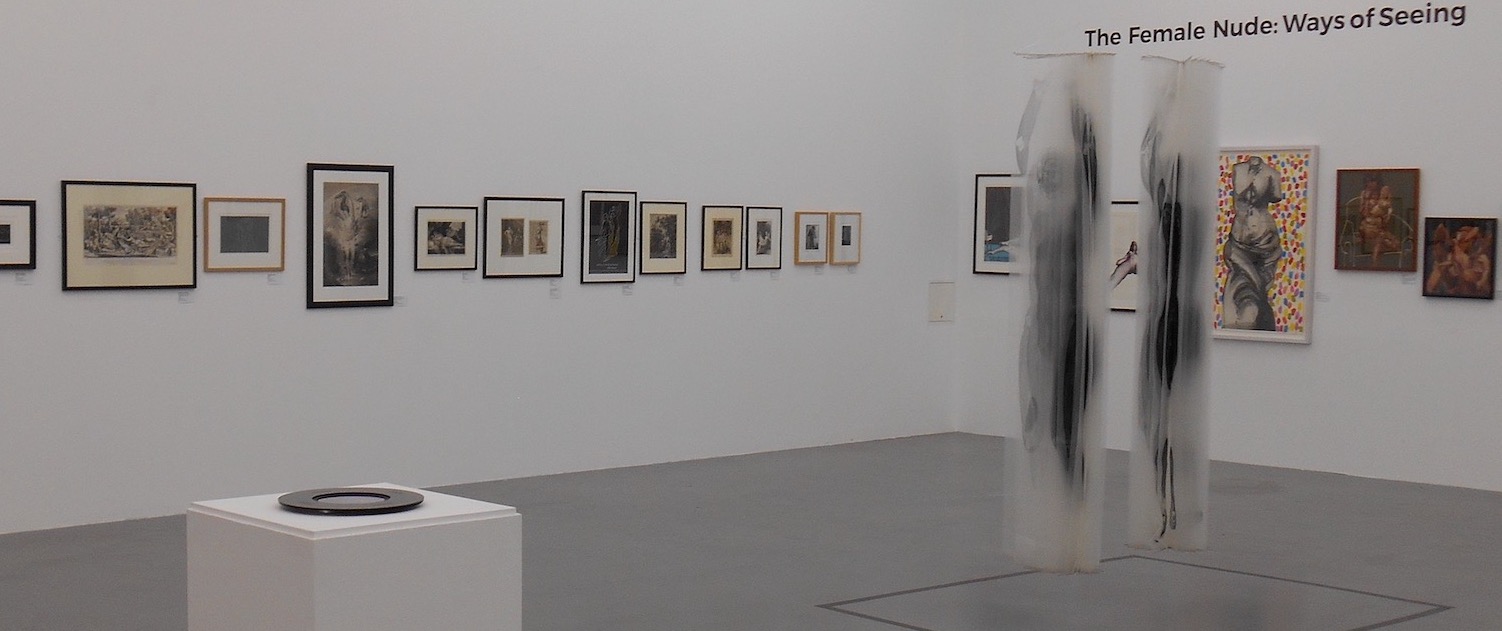The Baroque period can be characterised by an ‘intense religiosity’ or emotion in all facets of its forms whether it be theatre, painting, or sculpture. It was brought in by the Counter Revolution that caused a will back to religion especially Catholicism, previously seen by the people as unattainable to the average man (sermons and holy texts were taught it Latin, a language spoken by few etc.). The flamboyance of Catholic representation was almost offensive to those who had little to live by, so commissioned artworks sought to provide some justification or relation to the people. Thus emotional expressionism manifested into the art of the time. An example could be the naturalism of Caravaggio’s The boy with the Basket of Fruit (c.1593) compared to previous Renaissance pieces.
Who better was there to create a pride of this era than Bernini, specifically in his conception of the Ecstasy of Saint Teresa.

Gian Lorenzo Bernini, The Ecstasy of Saint Teresa (1647-52).
Cornaro Chapel, Santa Maria della Vittoria, Rome.
This piece was conceptualised and made in 1652 by Gian Lorenzo Bernini, commissioned under the Papacy of Pope Innocent X. It currently resides in The Cornaro Chapel in Rome and was patroned by Francesco Burronini, who’s influence can be seen in the architecture of the greater work.
Bernini both as a religious man and as someone willing to use his own pain to express passionate emotion was a clear fit for the era. His self-portrait, The Damned Soul (1619), expertly demonstrates his capability and use of the mirror to perfectly capture and translate his pose. As a prodigy, from a young age Bernini was accused as possessing some narcissism. He had tendency to use himself as a muse for religious figures which caused some controversy. He however was well rated among Popes and was therefore given reign to dominate the period.
Teresa, the subject of this piece, was canonized in 1622 and she accounts her visit from the ‘highest rank of angel’. They met her with an arrow with an iron tip that was ‘plunged into her heart several times until it penetrated to [her] entrails’ causing her to ‘utter several moans’. It is called a, ‘spiritual pain’, though the body had some share in it and this sculpture is Bernini’s attempt to physically represent the spiritual pleasure in serving Christ.

Gian Lorenzo Bernini, The Ecstasy of Saint Teresa (1647-52), detail.
He does this expertly through the underlying sexual symbolism as Teresa appears to be having a bodily orgasm from the expression on her face. The painterly effect of the marble seems to transcend the physical in the angelic versus the mortal. The angel appears to be defying gravity with the softness of its wings and dress. In juxtaposition Teresa has a heavy mortality that drags her to the earth.
Surrounding this, Bernini with his skills in architecture sets the stage. The visual elements of the spiritual interact with the proverbial ‘stage’. The theatre boxes at the sides are representations of the actual patron and his family, spectating and forming an interaction of real life. A hidden light source hides behind the rays of gold from a window. As the viewer walks up to the raised sculpture they are embraced by the light and warm of the elaborate designing. Above the sculpture, if you were to visit, you would see a white dove on the ceiling, representing the Holy Ghost as an additional spectator.
Bernini makes every attempt to draw us into the piece and engulf us in it.
The work clearly does what all Baroque work aimed to do: inspire faith and involve the viewer. And it did so with a spectacular level of drama. The physical embodiment of a spiritual Godly love creates a link between the elaborate and the average human, justifying the overindulgence linked to Catholicism. The work thus invites us all to feel of spirituality alongside Teresa, invoking in the viewers a sense of passion as required in art at this time . As Teresa is, in her own words, ‘utterly consumed by the Great love of God’, so are we the onlookers.
Reaia Parkes (BA Art History and Film, 1st Year)
